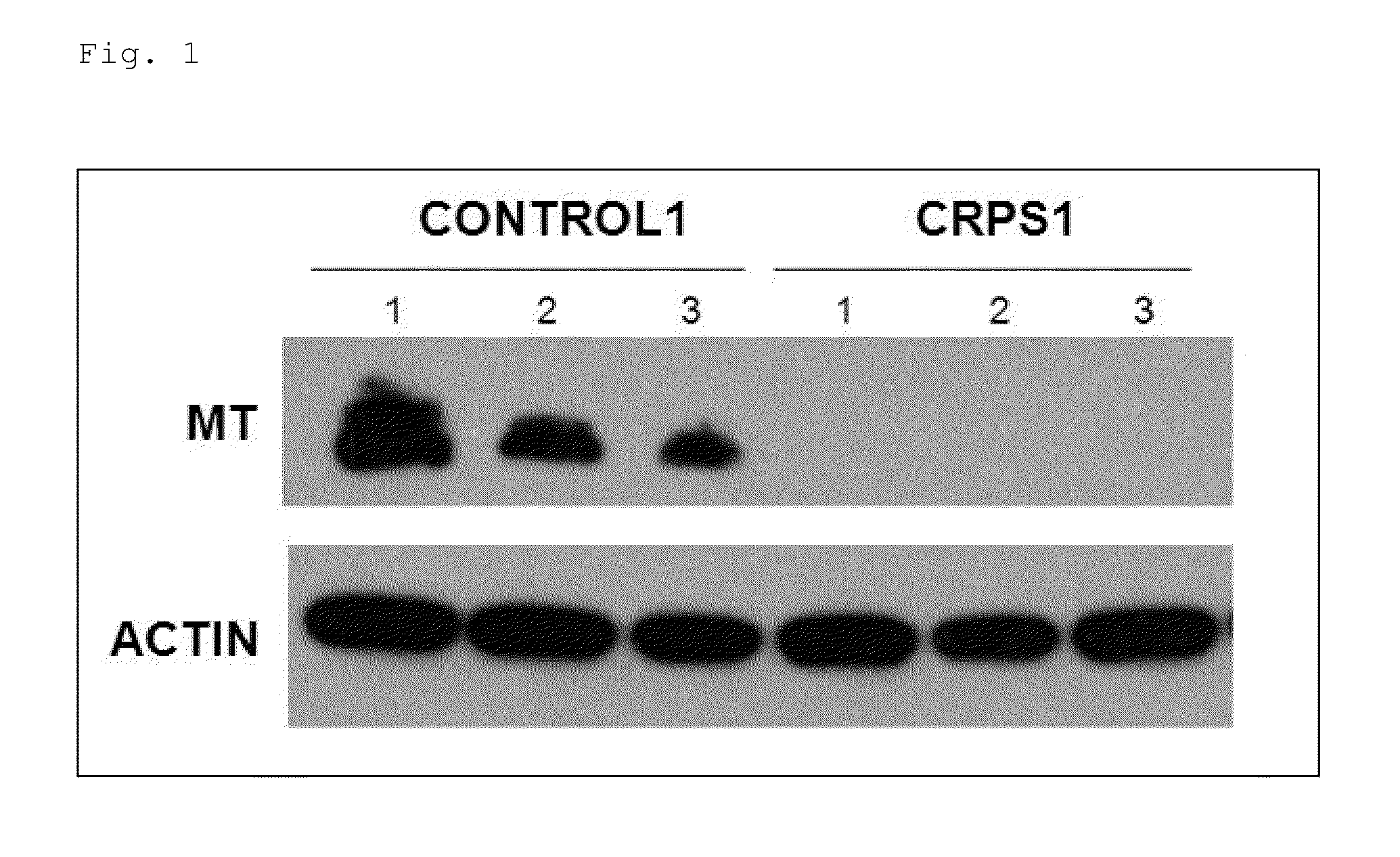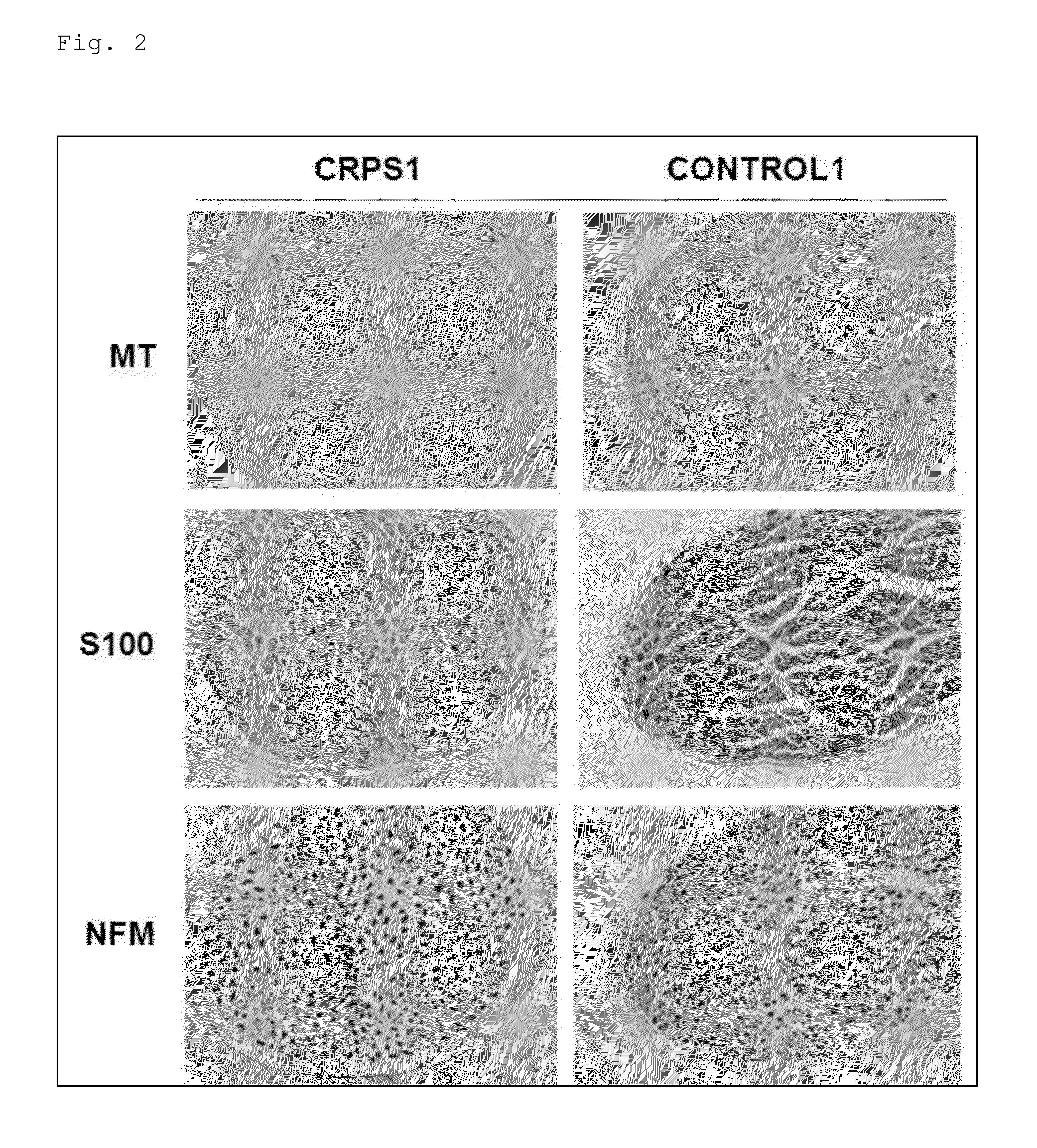Composition for treating, improving, or preventing pain
a technology for preventing pain and pain, applied in the field of composition and a method for treating, improving, or preventing pain, can solve the problems of confusion in the medical places where crps is treated, disease has not been elucidated, and the expression of mt protein is reduced, so as to prevent, improve, or treat pain, the effect of reducing the expression of mt protein
- Summary
- Abstract
- Description
- Claims
- Application Information
AI Technical Summary
Benefits of technology
Problems solved by technology
Method used
Image
Examples
example 1
Proteomic Analysis on Peripheral Nerves of CRPS Patients
[0076]Proteins were extracted from three specimens of peripheral nerves of CRPS patients (“CRPS1 to 3” described in Table 1), and from two specimens of sural nerves excised from fresh cadavers as controls (normal nerves) (“controls 1 and 2” described in Table 1). Both of which were stored at −80° C. after the excision. See Table 1 for details of the nerves used. Specifically, 5 mm of each nerve specimen was homogenized in 200 μL of an extraction buffer (40 mM Tris base, 0.5% Triton X-100, 10% glycerol, 5 mM EDTA, 2 mM Pefabloc), then shaken at 4° C. for 30 minutes, and further ultracentrifuged at 100,000 G at 4° C. for 30 minutes to separate the soluble fraction and the insoluble fraction from each other. To the obtained insoluble fraction, 100 μL of 1% SDS was further added. After heating at 70° C. for 30 minutes, the resultant was ultracentrifuged at 40000 g at 22° C. for 30 minutes to extract the supernatant. The soluble fra...
example 2
Analysis of MT Expression in Peripheral Nerve of CRPS Patients
[0083]From the result of the proteomic analysis on peripheral nerves of the CRPS patients, next, the expression and the localization of the MT protein in the peripheral nerves of the CRPS patients were analyzed by western blotting and immunostaining. FIG. 1, FIG. 2, Table 3, and Table 4 show the obtained results. Note that Table 3 shows the staining intensity of each protein (MT, S100, NFM) in each sample (the peripheral nerves of the CRPS patients (CRPS1 to 3) and the normal nerves (controls 1 to 3)). Table 4 shows the result of further immunostaining five CRPS specimens, two painful neuroma specimens, and 57 peripheral nerve specimens included in pathological blocks obtained by wide range excision owing to orthopedic diseases. In other words, Table 4 shows that the expression of the MT protein in each sample (peripheral nerves of the CRPS patients, painful neuroma patients, fresh cadavers, benign tumors, and malignant t...
example 3
Experiment of Locally Administering MT Protein to Seltzer Model
[0099]From the above result, a MT protein was locally administered to a seltzer model having neuropathic pain (neurogenic pain) in order to examine whether or not the MT protein had an effect on pain of the model. FIGS. 3 to 6 show the obtained result. Note that the model rats used, the method for preparing the MT protein to be administered to the model rats, the method for evaluating the model rats, and so forth are as described below. Moreover, the Seltzer model is also called a partial sciatic nerve ligation (partial sciatic nerve injury, PSL) model, and construed as a model for neuropathic pain (see Sasaki et al., Folia Pharmacologica Japonica, 2006, vol. 127, pp. 151 to 155).
[0100]
[0101]The surgery for the partial sciatic nerve ligation model (Seltzer model) was performed on eight SD rats (female, body weight: 240 to 260 g). Specifically, the rats were anesthetized by intraperitoneally administering 50 mg / kg of pent...
PUM
| Property | Measurement | Unit |
|---|---|---|
| pH | aaaaa | aaaaa |
| voltage | aaaaa | aaaaa |
| pH | aaaaa | aaaaa |
Abstract
Description
Claims
Application Information
 Login to View More
Login to View More - R&D
- Intellectual Property
- Life Sciences
- Materials
- Tech Scout
- Unparalleled Data Quality
- Higher Quality Content
- 60% Fewer Hallucinations
Browse by: Latest US Patents, China's latest patents, Technical Efficacy Thesaurus, Application Domain, Technology Topic, Popular Technical Reports.
© 2025 PatSnap. All rights reserved.Legal|Privacy policy|Modern Slavery Act Transparency Statement|Sitemap|About US| Contact US: help@patsnap.com



